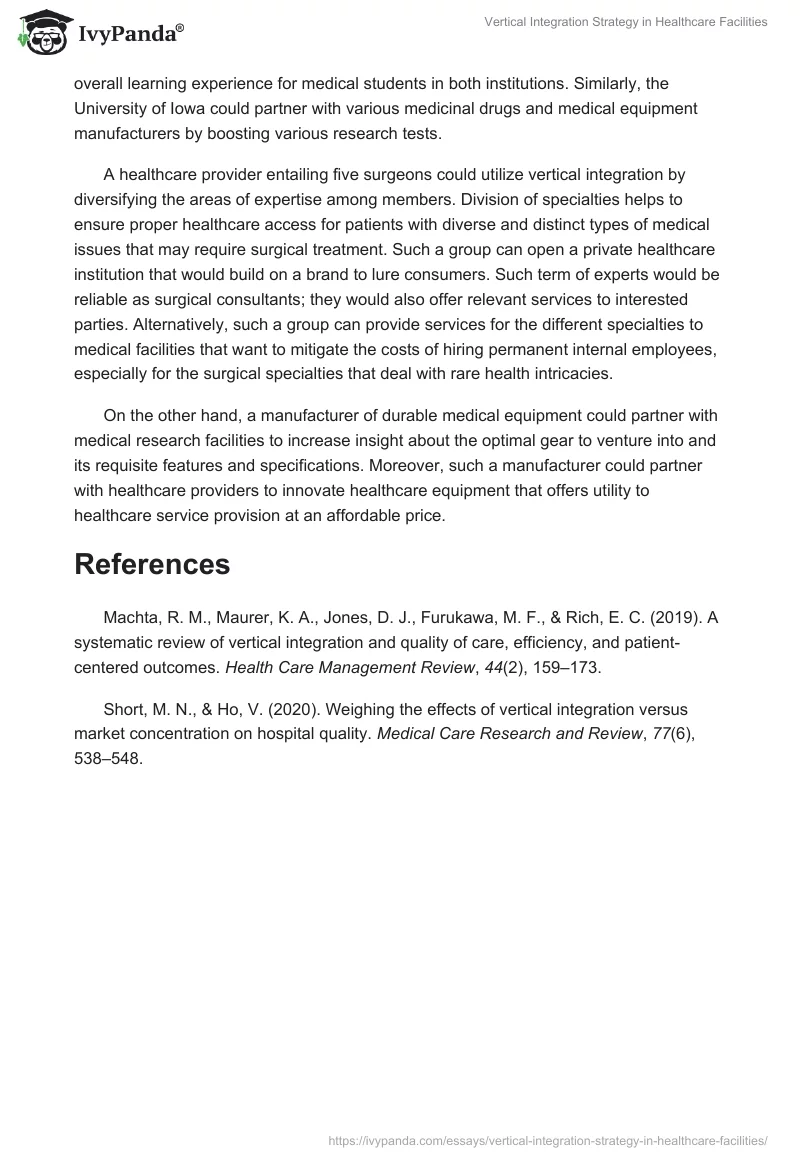Vertical integration in business refers to obtaining business operations to acquire more direct control over various stages within a product’s manufacturing cycle. Vertical integration helps an organization maximize profit by incurring the marginal cost alone and avoiding the need for any intermediaries. For example, a hotel that sells eggs can refrain from purchasing eggs from other farmers. Instead, it may decide to rear chicken and sell eggs yielded directly from the raised chicken. The concept of vertical integration has proved efficient for a myriad of industries. The utility of vertical integration within the healthcare sector has been demonstrated by its ability to achieve patient-oriented service while implementing cost-control techniques simultaneously. This paper seeks to reveal more profound information by assessing three scenarios discussing the issue.
The current healthcare system in the vast majority of countries worldwide has already embraced the vertical integration strategy. Doing so has drastically altered the healthcare service delivery model by increasing organizational concern to mitigate expenditure of operational costs (Short & Ho, 2020). Previously, healthcare institutions in most countries mainly focused on service delivery to patients. In contrast, the present state of the healthcare sector is characterized by high monetary incurrences. Hence patients have to pay to receive essential healthcare services. Since its introduction, the vertical integration strategy in healthcare has had a singular focus on cost mitigation in healthcare service delivery (Machta et al., 2019). It has resulted in a state where healthcare organizations desire to expand their scope of consumer services. Consequently, healthcare providers worldwide currently term quality healthcare service as the endowment of sophisticated infrastructure and diversity of specialties, which requires a financial capability to facilitate.
Therefore, there are various scenarios where the healthcare sector could benefit immensely from the vertical integration strategy. One scenario involves academic institutions that offer medicine as a course. For instance, the University of Iowa could utilize vertical integration by forming synergies with institutes of a similar caliber. Such partnerships would be deemed effective as they would present opportunities for people in both the University of Iowa and its partners to share resources and improve the overall learning experience for medical students in both institutions. Similarly, the University of Iowa could partner with various medicinal drugs and medical equipment manufacturers by boosting various research tests.
A healthcare provider entailing five surgeons could utilize vertical integration by diversifying the areas of expertise among members. Division of specialties helps to ensure proper healthcare access for patients with diverse and distinct types of medical issues that may require surgical treatment. Such a group can open a private healthcare institution that would build on a brand to lure consumers. Such term of experts would be reliable as surgical consultants; they would also offer relevant services to interested parties. Alternatively, such a group can provide services for the different specialties to medical facilities that want to mitigate the costs of hiring permanent internal employees, especially for the surgical specialties that deal with rare health intricacies.
On the other hand, a manufacturer of durable medical equipment could partner with medical research facilities to increase insight about the optimal gear to venture into and its requisite features and specifications. Moreover, such a manufacturer could partner with healthcare providers to innovate healthcare equipment that offers utility to healthcare service provision at an affordable price.
References
Machta, R. M., Maurer, K. A., Jones, D. J., Furukawa, M. F., & Rich, E. C. (2019). A systematic review of vertical integration and quality of care, efficiency, and patient-centered outcomes. Health Care Management Review, 44(2), 159–173.
Short, M. N., & Ho, V. (2020). Weighing the effects of vertical integration versus market concentration on hospital quality. Medical Care Research and Review, 77(6), 538–548.


